ProtoBuf简介
proto简介
一、protobuf的定义
protobuf是一种用于序列化结构数据的工具,实现数据的存储与交换,与编程语言和开发平台无关。
序列化:将结构数据或者对象转换成能够用于存储和传输的格式。
反序列化:在其他的计算环境中,将序列化后的数据还原为结构数据和对象。
定义数据的结构,然后使用protoc编译器生成源代码,在各种数据流中使用各种语言进行编写和读取结构数据。甚至可以更新数据结构,而不破坏由旧数据结构编译的已部署程序。
二、protobuf的优缺点
2.1、优点
- 性能高效:与XML相比,protobuf更小(3 ~ 10倍)、更快(20 ~ 100倍)、更为简单。
- 语言无关、平台无关:protobuf支持Java、C++、Python 等多种语言,支持多个平台。
- 扩展性、兼容性强:只需要使用protobuf对结构数据进行一次描述,即可从各种数据流中读取结构数据,更新数据结构时不会破坏原有的程序。
2.2、缺点
- 不适合用来对基于文本的标记文档(如 HTML)建模。
- 自解释性较差,数据存储格式为二进制,需要通过proto文件才能了解到内部的数据结构。
三、protobuf的使用流程
3.1、protobuf在Linux下的安装过程
$ sudo apt-get install autoconf automake libtool curl make g++ unzip
$ git clone https://github.com/google/protobuf.git
$ cd protobuf
$ git submodule update --init --recursive
$ ./autogen.sh
$ ./configure
$ make
$ make check
$ sudo make install
$ sudo ldconfig
3.2、定义proto文件
message Person {
string name = 1;
int32 id = 2;
string email = 3;
enum PhoneType {
MOBILE = 0;
HOME = 1;
WORK = 2;
}
message PhoneNumber {
string number = 1;
PhoneType type = 2;
}
repeated PhoneNumber phone = 4;
}
message是消息体,包含了多个fields(数据项),每一个fields都是key-value类型。
3.3、protoc编译器
使用proto文件定义好结构数据后,可以使用protoc编译器生成结构数据的源代码,这些源代码提供了读写结构数据的接口,从而能够构造、初始化、读取、序列化、反序列化结构数据。使用以下命令生成相应的接口代码:
// $SRC_DIR: .proto所在的源目录
// --cpp_out: 生成C++代码
// $DST_DIR: 生成代码的目标目录
// xxx.proto: 要针对哪个proto文件生成接口代码
protoc -I=$SRC_DIR --cpp_out=$DST_DIR $SRC_DIR/xxx.proto
编译完成后将会生成一个xxx.pb.h和xxx.pb.cpp文件,会提供类似SerializeToOstream()、set_name()、name()等方法。
3.4、调用接口进行序列化、反序列化
/*
下面的代码即为protoc编译器生成的原结构数据的接口,
提供了构造函数、初始化、序列化、反序列化和读取数据的方法,
因此可以调用这些接口进行序列化与反序列化。
*/
// 构造函数
Person person;
// 初始化
person.set_name("John Doe");
person.set_id(1234);
person.set_email("jdoe@example.com");
fstream output("myfile", ios::out | ios::binary);
// 序列化结构数据到文件中
person.SerializeToOstream(&output);
fstream input("myfile", ios::in | ios::binary);
Person person;
// 从文件中反序列化出结构数据
person.ParseFromIstream(&input);
// 读取结构数据
cout << "Name: " << person.name() << endl;
cout << "E-mail: " << person.email() << endl;
四、protobuf的应用场景
- 压缩效率高:服务器间的海量数据传输与通信,可以节省磁盘和带宽,protobuf适合处理大数据集中的单个小消息,但并不适合处理单个的大消息。
- 解析速度快:可以提高服务器的吞吐能力。
五、protobuf与json和XML的对比
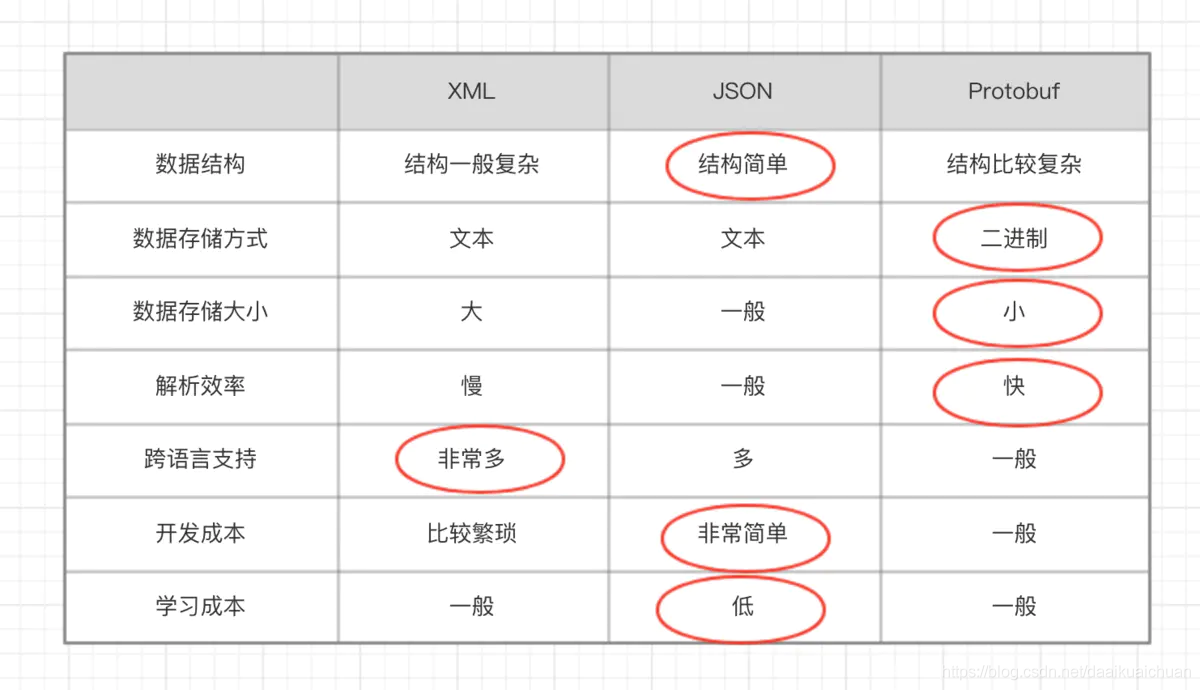
- XML、JSON、protobuf都具有数据结构化和数据序列化的能力。
- XML、JSON更注重数据结构化,关注可读性和语义表达能力;protobuf 更注重数据序列化,关注效率、空间、速度,可读性较差,语义表达能力不足。
- protobuf的应用场景更为明确,XML、JSON的应用场景更为丰富。
参考:
https://www.iteye.com/blog/maoyidao-1236916
https://www.jianshu.com/p/cae40f8faf1e
https://www.jianshu.com/p/a24c88c0526a
protobuf语法详解
一、包(package)
为.proto文件添加package声明符,可以防止不同 .proto项目间消息类型的命名发生冲突。
package foo.bar;
message Open { ... }
message Foo {
...
foo.bar.Open open = 1;
...
}
protobuf包类型的解析和C++类似,都是由内而外进行解析。对于C++,产生的类会被包装在C++的命名空间中,如上例中的Open会被封装在 foo::bar空间中。
二、选项(option)
option会影响特定环境下的处理方式,但是不会改变整个文件声明的含义。
option optimize_for = CODE_SIZE;
1

三、消息类型(message)
message用于定义结构数据,可以包含多种类型字段(field),每个字段声明以分号结尾。message经过protoc编译后会生成对应的class类,field则会生成对应的方法。
syntax = "proto3"; // 表示使用的protobuf版本是proto3
message SearchRequest {
string query = 1;
int32 page_number = 2;
int32 result_per_page = 3;
}
1234567
3.1、常规消息类型
3.1.1、字段修饰符
在proto3中,去掉了required和optional,对于原始数据类型字段不再提供 hasxxx()方法,只有单个字段或者重复字段:
- 单个字段:表示字段可以出现0次或者1次。
- repeated:表示字段可以重复任意次。
3.1.2、字段类型
3.1.2.1、标量类型
protobuf标量数据类型与各平台的数据类型对应如下表:
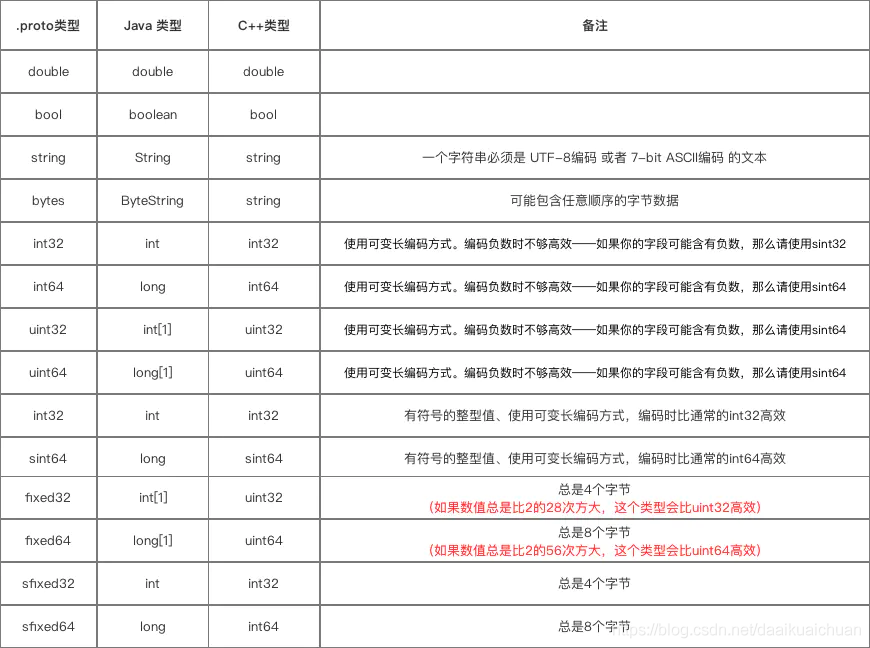
3.1.2.2、枚举类型
protobuf中的enum类型和C++中的枚举类型相似,表示字段取值的集合。
message SearchRequest {
string query = 1;
int32 page_number = 2;
int32 result_per_page = 3;
enum Corpus {
UNIVERSAL = 0;
WEB = 1;
IMAGES = 2;
LOCAL = 3;
NEWS = 4;
PRODUCTS = 5;
VIDEO = 6;
}
Corpus corpus = 4;
}
枚举类型中第一个元素的值必须从0开始,而且proto3中删除了default标记,默认值为第一个元素。
当枚举类型是在某一个消息内部定义,但是希望在另一个消息中使用时,需要采用MessageType.EnumType的语法格式。
3.1.2.3、Any类型
protobuf中的Any类型与C++中的泛型概念类似,可以定义为任意的类型。在序列化的时候可以通过PackFrom()方法将任意的数据类型打包为Any类型,反序列化的时候通过UnpackTo()把Any类型还原为原始类型。
// 要使用Any类型必须导入该proto文件
import "google/protobuf/any.proto";
message ErrorStatus {
string message = 1;
repeated google.protobuf.Any details = 2;
}
// Storing an arbitrary message type in Any.
NetworkErrorDetails details = ...;
ErrorStatus status;
status.add_details()->PackFrom(details);
// Reading an arbitrary message from Any.
ErrorStatus status = ...;
for (const Any& detail : status.details()) {
if (detail.Is<NetworkErrorDetails>()) {
NetworkErrorDetails network_error;
detail.UnpackTo(&network_error);
... processing network_error ...
}
}
3.1.2.4、oneof类型
protobuf中的oneof类似与C++中的联合体类型相似,所有的字段共享内存,最多只能同时设置一个字段,设置oneof的任何字段会自动清除所有其他字段,可以使用case()或WhichOneof()方法检查oneof中使用的是哪个字段。
message SampleMessage {
oneof test_oneof {
string name = 4;
SubMessage sub_message = 9;
}
}
【oneof特性】:
- 设置oneof会自动清除其它oneof字段的值:
SampleMessage message;
message.set_name("name");
CHECK(message.has_name());
message.mutable_sub_message(); // Will clear name field.
CHECK(!message.has_name());
- oneof不能声明为repeated类型。
- 注意不要出现内存崩溃问题:
SampleMessage message;
SubMessage* sub_message = message.mutable_sub_message();
message.set_name("name"); // Will delete sub_message
sub_message->set_... // Crashes here
- 可以在oneof内部添加和删除field,但是删除和添加oneof要小心
3.1.2.5、map类型
protobuf中的map类似与STL中的关联型容器相似,map是key-value类型,key可以是int或者string,value可以是自定义message。
map<key_type, value_type> map_field = N;
// 与上述定义等价
message MapFieldEntry {
key_type key = 1;
value_type value = 2;
}
repeated MapFieldEntry map_field = N;
【map特性】:
- map不能定义为repeated类型。
- 当为.proto文件产生生成文本格式的时候,map会按照key 的顺序排序,数值化的key会按照数值排序。
- 从序列化中解析时,如果有重复的key,只会使用第一个key。
3.1.3、默认值说明
- string类型,默认值是空字符串。
- bytes类型,默认值是空bytes。
- bool类型,默认值是false。
- 数字类型,默认值是0。
- 枚举类型,默认值是第一个枚举值,即0。
- repeated修饰的属性,默认值是空。
3.1.4、标识号
在消息类型中,每一个字段都有一个唯一的标识符(Tag),不应该随意改动。
[1-15]内的标识号在编码时只占用一个字节,包含标识符和字段类型,[16-2047]之间的标识符占用2个字节。建议为频繁出现的字段使用[1-15]间的标识符。
如果考虑到以后可能扩展元素,可以预留一些标识符或者字段。注意不能在一个reserved声明中混合使用字段名和标识符。
message Foo {
reserved 2, 15, 9 to 11;
reserved "foo", "bar";
}
最小的标识符可以从1开始,最大到2^29 - 1,或536,870,911。不可以使用[19000-19999]之间的标识符, Protobuf协议实现中预留了这些标识符。在.proto文件中使用这些预留标识号,编译时就会报错。
3.2、多个消息类型
一个.proto文件中可以定义多个消息类型:
syntax = "proto3";
// SearchRequest 搜索请求
message SearchRequest {
string query = 1; // 查询字符串
int32 page_number = 2; // 页码
int32 result_per_page = 3; // 每页条数
}
// SearchResponse 搜索响应
message SearchResponse {
...
}
3.3、嵌套消息类型
在protobuf中message之前可以嵌套使用:
message SearchResponse {
message Result {
string url = 1;
string title = 2;
repeated string snippets = 3;
}
repeated Result results = 1;
}
内部声明的消息message名称只可在内部直接使用,在外部使用需要添加父级message名称(Parent.Type):
message SomeOtherMessage {
SearchResponse.Result result = 1;
}
支持多层嵌套:
message Outer { // Level 0
message MiddleAA { // Level 1
message Inner { // Level 2
int64 ival = 1;
bool booly = 2;
}
}
message MiddleBB { // Level 1
message Inner { // Level 2
int32 ival = 1;
bool booly = 2;
}
}
}
3.4、更新消息类型
如果一个已有的消息类型已无法满足新的需求,比如需要添加一个额外的字段,但是同时旧版本写的代码仍然可用。在更新消息类型需要遵循以下规则:
- 不要更改任何已有字段的标识号。
- int32、uint32、int64、uint64,和bool是全部兼容的,这意味着可以将这些类型中的一个转换为另外一个,而不会破坏向前、 向后的兼容性。
- sint32和sint64是互相兼容的,但是它们与其他整数类型不兼容。
- string和bytes是兼容的,只要bytes是有效的UTF-8编码。
- 嵌套消息与bytes是兼容的,只要bytes包含该消息的一个编码过的版本。
- fixed32与sfixed32是兼容的,fixed64与sfixed64是兼容的。
四、RPC服务(service)
如果想要将消息类型用在远程方法调用(RPC)系统中,可以在.proto文件中定义一个RPC服务接口。
service UserService {
// 包含方法名、方法参数和返回值,
// 接收SearchRequest并返回一个SearchResponse
rpc GetUser(Request) returns (Response);
}
gRPC在使用protobuf时非常有效,如果使用特殊的protobuf插件可以直接从.proto文件中产生相关的RPC代码。
五、其他
5.1 导入proto文件(import)
如果希望在当前proto文件中引用其他的proto文件中的内容,可以使用import:
import "other_project/other_protos.proto";
参考:
https://developers.google.cn/protocol-buffers/docs/proto3#oneof
https://segmentfault.com/a/1190000007917576#item-1-10
https://www.jianshu.com/p/e06ba6249edc
protobuf语法风格
一、代码风格
- 每一行的代码长度不要超过80。
- 使用两个空格进行缩进。
二、文件格式
文件命名应该采用蛇形命名法(即用下划线连接),如:lower_snake_case.proto。所有文件应以下列方式排列:
- License header (if applicable)
- File overview
- Syntax
- Package
- Imports (sorted)
- File options
- Everything else
三、包
包名应该是小写的,并且应该对应于目录层次结构。例如,如果一个文件位于my/Package/*中,那么包名应该是*my.Package。
四、消息类型和字段
消息名使用驼峰命名法,例如:SongServerRequest,字段名和扩展名使用小写的下划线分隔式,例如:song_name。
message SongServerRequest {
required string song_name = 1;
}
123
const string& song_name() { ... }
void set_song_name(const string& x) { ... }
如果字段名包含数字,则该数字应出现在字母之后,而不是下划线之后。例如:song_name1。
五、repeated字段
repeated字段使用复数命名:
repeated string keys = 1;
repeated MyMessage accounts = 17;
六、枚举类型
枚举名使用使用驼峰命名法,成员使用大写的下划线分隔式:
enum Foo {
FOO_UNSPECIFIED = 0;
FOO_FIRST_VALUE = 1;
FOO_SECOND_VALUE = 2;
}
七、服务
服务名称和任何RPC方法名称均使用驼峰命名法:
service FooService {
rpc GetSomething(FooRequest) returns (FooResponse);
}
参考:
https://developers.google.cn/protocol-buffers/docs/style
protobuf使用实例
一、描述proto文件
proto文件名称为addressbook.proto。
syntax = "proto3";
import "google/protobuf/any.proto";
// package类似于namespace,可以避免命名冲突
package AddressBookInfo;
// message类似于class
message Person
{
string name = 1;
int32 id = 2;
string email = 3;
// 枚举类型
enum PhoneType
{
MOBILE = 0;
HOME = 1;
WORK = 2;
}
message PhoneNumber
{
string number = 1;
// proto3中enum没有default选项,把第一个值作为default
PhoneType type = 2;
}
// repeated表示message或者filed可以重复多次
repeated PhoneNumber phones = 4;
}
message Address
{
string address = 1;
}
message AddressBook
{
string owner = 1;
repeated Person person_infos = 2;
/*
** oneof类似于union类型,某一个时刻只能设置一个field,所有的field共享同一段内存。
** 设置oneof字段将自动清除oneof的所有其他字段,即只能同时设置(set_)一个,不然就会core dump。
** 可以在oneof内部添加和删除field,但是删除和添加oneof要小心。
** oneof中数据成员的编号建议承上启下,尽量不要随意编号。
*/
oneof PayType
{
string type_ali = 3;
string type_wx = 4;
}
/*
** map是key-value类型,key可以是int或者string,value可以是自定义message。
** Any用来实现泛型,可以表示任意类型。
*/
map<string, google.protobuf.Any> owner_address = 5;
}
二、编译proto文件
使用protoc编译器对proto文件进行编译,生成addressbook.pb.h和addressbook.pb.cc。

三、生成protobuf API
打开addressbook.pb.h和addressbook.pb.cc,可以看到自动生成了很多的API,后续可以使用这些API读写数据。
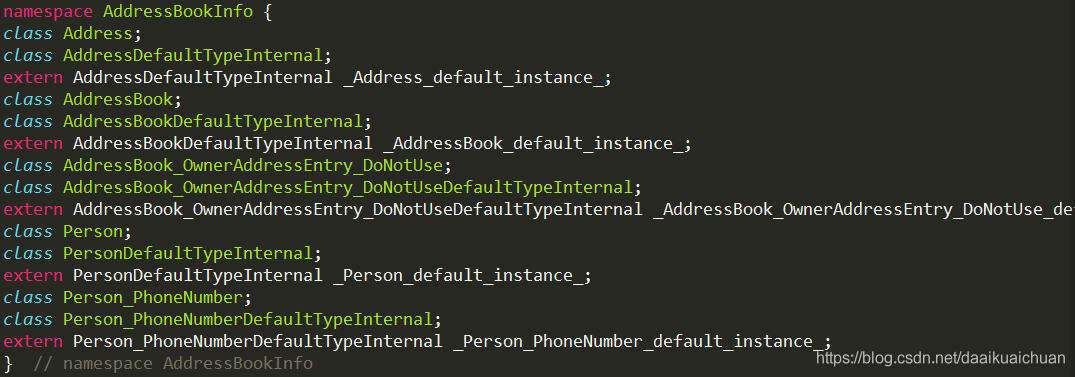
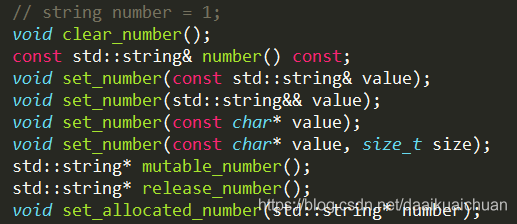

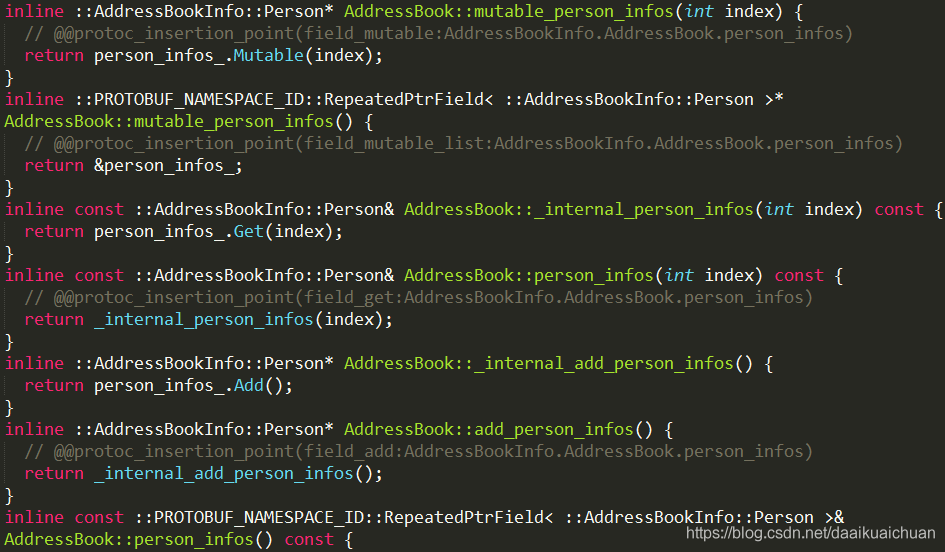
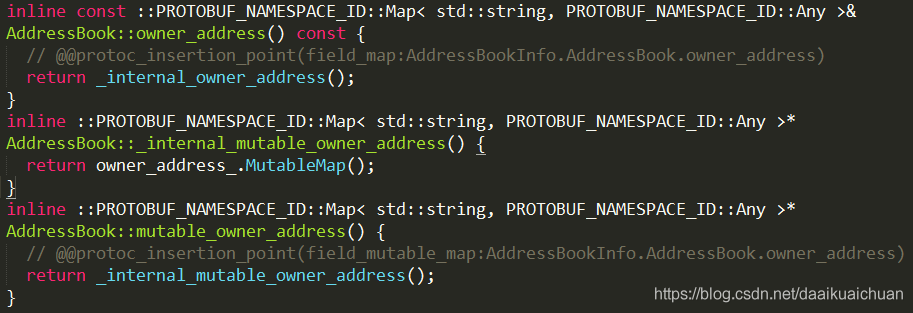
四、使用API写入和读取数据
addressbook.cpp文件中阐述了如何使用protobuf自动生成的API读写数据,基本上覆盖了常用的消息类型。
具体的API及使用方式可以参考:https://developers.google.cn/protocol-buffers/docs/reference/cpp-generated
#include <iostream>
#include <fstream>
#include "addressbook.pb.h"
#include <google/protobuf/any.h>
using namespace std;
void SaveInfo()
{
AddressBookInfo::AddressBook adbook;
// 使用set_设置message中filed的值,函数名都是小写(即使在proto中是大写)
adbook.set_owner("eric");
// Person1
// 使用add_添加message,返回的是指针类型
AddressBookInfo::Person *person1 = adbook.add_person_infos();
person1->set_name("mark");
person1->set_id(123456);
person1->set_email("mark@163.com");
AddressBookInfo::Person::PhoneNumber *person1_phone = person1->add_phones();
person1_phone->set_number("12345678");
// 枚举类型中的元素名称是唯一的,所以可以直接用作用域限定符访问元素,不需要通过枚举名访问
person1_phone->set_type(AddressBookInfo::Person::HOME);
person1_phone = person1->add_phones();
person1_phone->set_number("1234");
person1_phone->set_type(AddressBookInfo::Person::WORK);
// Person2
AddressBookInfo::Person *person2 = adbook.add_person_infos();
person2->set_name("mike");
person2->set_id(654321);
person2->set_email("mike@163.com");
AddressBookInfo::Person::PhoneNumber *person2_phone = person2->add_phones();
person2_phone->set_number("87654321");
person2_phone->set_type(AddressBookInfo::Person::HOME);
person2_phone = person2->add_phones();
person2_phone->set_number("5678");
person2_phone->set_type(AddressBookInfo::Person::WORK);
// map和any类型的初始化,mutable返回的是非const指针类型
google::protobuf::Map<string, google::protobuf::Any> *owner_address = adbook.mutable_owner_address();
// 定义一个Any类型,用于接收message
google::protobuf::Any *any = new google::protobuf::Any;
AddressBookInfo::Address adbook_address;
adbook_address.set_address("HB");
// 使用PackFrom将message类型存储为Any类型
any->PackFrom(adbook_address);
// map类型的初始化方式和STL中的map类似
(*owner_address)[adbook.owner()] = *any;
// 设置oneof中某一个成员的值,之后如果再使用set_则会core dump
adbook.set_type_ali("AliPay");
fstream output("address_book_file", ios::out | ios::trunc | ios::binary);
// 使用SerializeToOstream将序列化后的数据写入文件中
if (!adbook.SerializeToOstream(&output))
{
cerr << "Failed to write address book." << endl;
}
}
void ShowMsg(const AddressBookInfo::AddressBook &adbook)
{
cout << adbook.owner() << endl;
// 对于重复message,_size表示有多少个重复message,使用索引取出每一个message
for (int i = 0; i < adbook.person_infos_size(); ++i)
{
const AddressBookInfo::Person &person = adbook.person_infos(i);
// 取出各个字段的值
cout << person.name() << endl;
cout << person.id() << endl;
cout << person.email() << endl;
for (int j = 0; j < person.phones_size(); ++j)
{
// 使用索引获取枚举类型的所有值
const AddressBookInfo::Person::PhoneNumber &person_phone = person.phones(j);
switch(person_phone.type())
{
case AddressBookInfo::Person::MOBILE :
cout << "MOBILE phone #: ";
break;
case AddressBookInfo::Person::HOME :
cout << "HOME phone #: ";
break;
case AddressBookInfo::Person::WORK :
cout << "WORK phone #: ";
break;
}
cout << person_phone.number() << endl;
}
}
cout << adbook.type_ali() << endl;
}
void ShowMapMsg(const AddressBookInfo::AddressBook &adbook)
{
// 取出map类型的字段成员
const google::protobuf::Map<string, google::protobuf::Any> &adbook_map = adbook.owner_address();
// 使用迭代器访问map(和STL中的map类似)
auto iter = adbook_map.begin();
cout << iter->first << endl;
google::protobuf::Any any = iter->second;
AddressBookInfo::Address adbook_address;
// 使用UnpackTo从Any类型解析出message,注意参数中有一个&
if (any.UnpackTo(&adbook_address))
{
cout << adbook_address.address() << endl;
}
else
{
cout << "UnpackTo data error" << endl;
}
}
void LoadInfo()
{
AddressBookInfo::AddressBook adbook;
fstream input("address_book_file", ios::in | ios::binary);
// 使用ParseFromIstream从文件中反序列化
if (!input)
{
cout << ": File not found. Creating a new file." << endl;
}
else if (!adbook.ParseFromIstream(&input))
{
cout << "Failed to parse address book." << endl;
}
ShowMsg(adbook);
cout << endl;
ShowMapMsg(adbook);
}
int main(int argc, char const *argv[])
{
SaveInfo();
LoadInfo();
// 删除所有已分配的内存(注意any是堆上的内存,清除内存的操作要小心)
google::protobuf::ShutdownProtobufLibrary();
return 0;
}
五、编译所有的CPP文件
使用g++编译所有的CPP文件,注意编译参数需要加上:-std=c++11、-lprotobuf、-lpthread。

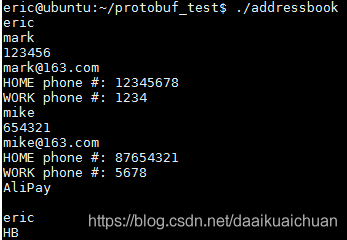
六、编译和运行中遇到的问题
(1)如果没有添加-std=c++11选项则会出现以下问题:

(2)针对oneof类型,如果同时设置了多个字段或者字段编号混乱,则会出现以下问题:

#define _CRT_SECURE_NO_WARNINGS
#include <string.h>
#include <stdlib.h>
#include <iostream>
#include <string>
using namespace std;
#include "../proto/person.pb.h"
#if 0
int main(int argc, char** argv)
{
//1.定义要传送数据的对象 对应message后跟的名字
Person p;
//2.初始化对象
p.set_name("大圣");
p.set_email("wukong@163.com");
p.set_id(1700);
cout << p.name() << " " << p.id() << " " << p.email() << endl;
//3.将这个数据对象序列化
string out;
p.SerializeToString(&out);
//4.使用string对象里面存放的数据,反序列化数据对象
Person monkey;
monkey.ParseFromString(out);
cout << monkey.name() << " " << monkey.id() << " " << monkey.email() << endl;
system("Pause");
return 0;
}
#else
//传递一个信息类型的字符串,那么这个工厂就会帮我们构造出一个对应的类的实例
//"Person"字符串-->Person的实例 -->返回的是一个基类Message类的指针
//基类指针 指向子类实例
//create_message -->delete 来删除对象实例
google::protobuf::Message* create_message(const char* typeName) {
//message类
google::protobuf::Message* message = NULL;
// 根据名字,找到message的描述对象
const google::protobuf::Descriptor* descriptor =
google::protobuf::DescriptorPool::generated_pool()->FindMessageTypeByName(typeName);
if (descriptor) {
//根据描述对象到对象工厂里面,生成对应的模板对象
const google::protobuf::Message* prototype =
google::protobuf::MessageFactory::generated_factory()->GetPrototype(descriptor);
if (prototype) {
//根据模板对象克隆一个
message = prototype->New();
}
}
return message;
}
int main(int argc, char** argv)
{
//基类的message-->Person类的实例
google::protobuf::Message* msg = create_message("Person");
/*
Person* hou = (Person*)msg;
hou->set_name("大圣");
cout << hou->name() << endl;
*/
/*
每个message对象包含两个对象:
google::protobuf::Descriptor 描述对象-->获取message的描述信息 字段名以及类型等-->包含每一个field的描述
google::protobuf::Reflection 反射对象--> 使用这个对象 + field描述, 能get/set每个field的值
*/
const google::protobuf::Descriptor* des = msg->GetDescriptor();
const google::protobuf::Reflection* ref = msg->GetReflection();
//设置
// name
// 1. 通过des获取
const google::protobuf::FieldDescriptor* fd_des = des->FindFieldByName("name"); //通过字段名字设置数据
// 2.通过ref进行设置
ref->SetString(msg, fd_des, "大圣");
//age
fd_des = des->FindFieldByNumber(2); //通过字段标识号设置数据
ref->SetInt32(msg, fd_des, 1500);
//email
fd_des = des->FindFieldByName("email");
ref->SetString(msg, fd_des, "wukong@163.com");
//数组 使用AddInt32一个一个追加进去
fd_des = des->FindFieldByName("set");
ref->AddInt32(msg, fd_des, 1);
ref->AddInt32(msg, fd_des, 2);
ref->AddInt32(msg, fd_des, 3);
ref->AddInt32(msg, fd_des, 4);
//获取
for (int i = 0; i < des->field_count(); i++)
{
//获取每一个field描述对象
const google::protobuf::FieldDescriptor* fd = des->field(i);
//(1) 获取名字
cout << fd->name() << endl; //字段名字 不是数据 如:name age
cout << fd->type_name() << endl; //类型
cout << fd->cpp_type_name() << endl; //c++类型 bytes被换成了string
// 判断字段规则
// fd->is_repeated() 是否是数组
// fd->is_optional() 是否是非必须
// fd->is_required() 是否是必须
if (!fd->is_repeated()) {
//获取数据
switch (fd->cpp_type())
{
case google::protobuf::FieldDescriptor::CppType::CPPTYPE_INT32:
cout << ref->GetInt32(*msg, fd) << endl;
break;
case google::protobuf::FieldDescriptor::CppType::CPPTYPE_STRING:
cout << ref->GetString(*msg, fd) << endl;
break;
}
}
else {
for (int j = 0; j < ref->FieldSize(*msg, fd); j++) //ref->FieldSize(*msg, fd)获取数组长度
{
switch (fd->cpp_type())
{
case google::protobuf::FieldDescriptor::CppType::CPPTYPE_INT32:
cout << ref->GetRepeatedInt32(*msg, fd,j) << " "; //使用GetRepeatedInt32 便利数组
break;
case google::protobuf::FieldDescriptor::CppType::CPPTYPE_STRING:
cout << ref->GetRepeatedString(*msg, fd,j) << " ";
break;
}
}
cout << endl;
}
cout << fd->number() << endl; //获取字段标识号
}
//删除
delete msg;
system("Pause");
return 0;
}
#endif
linux 安装 protoc
- 环境 #54~20.04.1-Ubuntu SMP
- protoc 安装
下载地址:https://github.com/protocolbuffers/protobuf/releases 找到自己需要的版本
这里下载版本:https://github.com/protocolbuffers/protobuf/archive/refs/tags/v3.9.2.tar.gz
cd /tmp
wget https://github.com/protocolbuffers/protobuf/archive/refs/tags/v3.9.2.tar.gz
tar -zxvf v3.9.2.tar.gz
cd /protobuf-3.9.
sudo ./autogen.sh
sudo ./configure
sudo make
sudo make install
确认是否安装
protoc --version
出现异常
protoc: error while loading shared libraries: libprotoc.so.20: cannot open shared object file: No such file or directory
查阅资料,解决办法
export LD_LIBRARY_PATH=/usr/local/lib
再次测试,命令正常
将 export LD_LIBRARY_PATH=/usr/local/lib 加到 /etc/profile 文件中,以免下次使用失效
将 protoc 命令放到 GOBIN 目录
which protoc
cp /usr/local/bin/protoc $GOBIN/
- 安装 protoc-gen-go
go install github.com/golang/protobuf/protoc-gen-go@v1.4.2
- 安装 protoc-gen-grpc-gateway
go install github.com/grpc-ecosystem/grpc-gateway/protoc-gen-grpc-gateway@v1.15
- 安装 protoc-gen-swagger
go install github.com/grpc-ecosystem/grpc-gateway/protoc-gen-swagger@v1.15
- 安装 protoc-gen-gofast
go install github.com/gogo/protobuf/protoc-gen-gofast@latest



【推荐】国内首个AI IDE,深度理解中文开发场景,立即下载体验Trae
【推荐】编程新体验,更懂你的AI,立即体验豆包MarsCode编程助手
【推荐】抖音旗下AI助手豆包,你的智能百科全书,全免费不限次数
【推荐】轻量又高性能的 SSH 工具 IShell:AI 加持,快人一步
· winform 绘制太阳,地球,月球 运作规律
· 震惊!C++程序真的从main开始吗?99%的程序员都答错了
· 【硬核科普】Trae如何「偷看」你的代码?零基础破解AI编程运行原理
· AI与.NET技术实操系列(五):向量存储与相似性搜索在 .NET 中的实现
· 超详细:普通电脑也行Windows部署deepseek R1训练数据并当服务器共享给他人